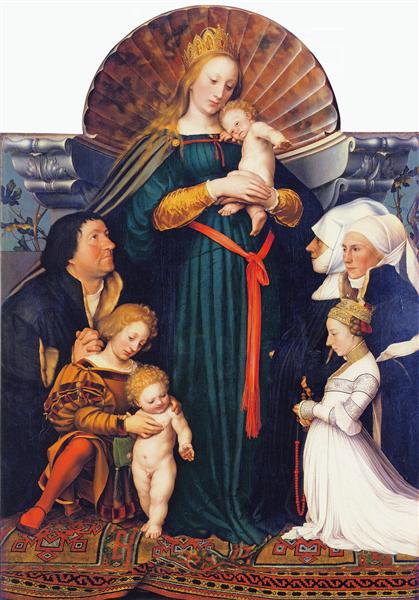Beskrivelse
Maleriet "Virgen del Bürgermeister Meyer" (1528), laget av Hans Holbein den unge mannen, står som et mesterverk av den tyske renessansen, som symboliserer skjæringspunktet mellom religiøs hengivenhet og figurativ representasjon. Dette arbeidet skiller seg ikke bare ut for sin tekniske mestring, men også for dens evne til å fange opp essensen av tiden, så vel som kompleksitetene i tro og samfunn i sin tid.
I sentrum av komposisjonen blir Jomfru Maria presentert som en majestetisk skikkelse som holder barnet Jesus i fanget hennes. Marias posisjon er både mors og verdig, med hennes rolige blikk som utstråler en dyp ro. Klærne hans, rik på teksturer og detaljer, er utsmykket med en blå mantel som symboliserer renhet og guddommelighet. Holbein bruker en fargepalett som spenner fra de livlige tonene på det røde og blå, i kontrast til de subtile skinnnuansene i de menneskelige figurene. Denne fargen bruker ikke bare den sentrale figuren, men etablerer også en visuell dialog med den mest dystre bakgrunnen, og gir en atmosfære av intim hengivenhet.
Et bemerkelsesverdig aspekt av dette arbeidet er forholdet til Bürgermeiseter Meyer, hvis portrett, på høyre side, gir et personlig og moderne element til scenen. Meyer, kledd i klær av borgerskapet, blir presentert i en hengivenhet, som forsterker ideen om at hellighet ikke bare tilhører himmelen, men også kan omfavnes av dødelige. Denne tilnærmingen til figuren til Bourgeois er karakteristisk for Holbein, som hadde evnen til å plassere de fremtredende skikkelsene i sin tid innenfor religiøse sammenhenger, og dermed gjenspeiler viktigheten av den fremvoksende middelklassen i Tyskland fra det sekstende århundre.
Den nøye oppmerksomheten på detaljer i Marias ansikt og barnet er et vitnesbyrd om Holbeins dominans over realistisk representasjon. De delikate og nesten følbare trekkene til karakterene inviterer betrakteren til en dypere forbindelse med maleriets fortelling. Bruken av lys- og skygge modellerer formene på en subtil måte, og tilfører volum og dybde, som blir et særegent element i kunstnerens teknikk.
Holbein, en pioner med portrett og religiøs representasjonsmaleri, innlemmet ofte elementer i hans moderne miljø i sine verk, et trekk som også kan observeres i hans portretter av fremtredende figurer av renessansen. Verker som "The Portrait of Erasmus de Rotterdam" deler en tilnærming til psykologi og karakteriseringen av den menneskelige figuren som gjenspeiles i Virgen del Bürgermeister Meyer, men dette maleriet går videre, og kobler den individuelle individualiteten til den borgerlige med det hellige.
Det er ikke bare et kunstverk, men også en uttalelse om det nye forholdet mellom religion og hverdag. Den historiske konteksten av dens skapelse i Basel, i løpet av en tid med svulstig religiøs endring, tilfører et annet lag med mening. Dette arbeidet fanger overgangen i religiøs representasjon, der jomfruens og barnet ikke bare er guddommelige, men også tilgjengelig for betrakteren, og bringer dem nærmere en åndelig opplevelse som overskrider tidens barrierer.
Avslutningsvis er "Virgen del Bürgermeister Meyer" av Hans Holbein den unge mannen ikke bare et sublimt maleri når det den guddommelige fortellingen. Det er et strålende eksempel på hvordan kunst kan tjene som et kulturspeil, og gjenspeiler ikke bare spiritualiteten i en tid, men menneskeheten delte i sin dypeste essens. Holbeins evne til å flette sammen disse elementene sikrer sin plass i kunsthistorien, som en av de største mestrene i sin tid.
KUADROS ©, en berømt maling på veggen din.
Håndlagde oljemalerier, med kvaliteten på profesjonelle kunstnere og den særegne forseglingen til KUADROS ©.
Bilder reproduksjonstjeneste med tilfredshetsgaranti. Hvis du ikke er helt fornøyd med kopien av maleriet ditt, refunderer vi pengene dine 100%.

